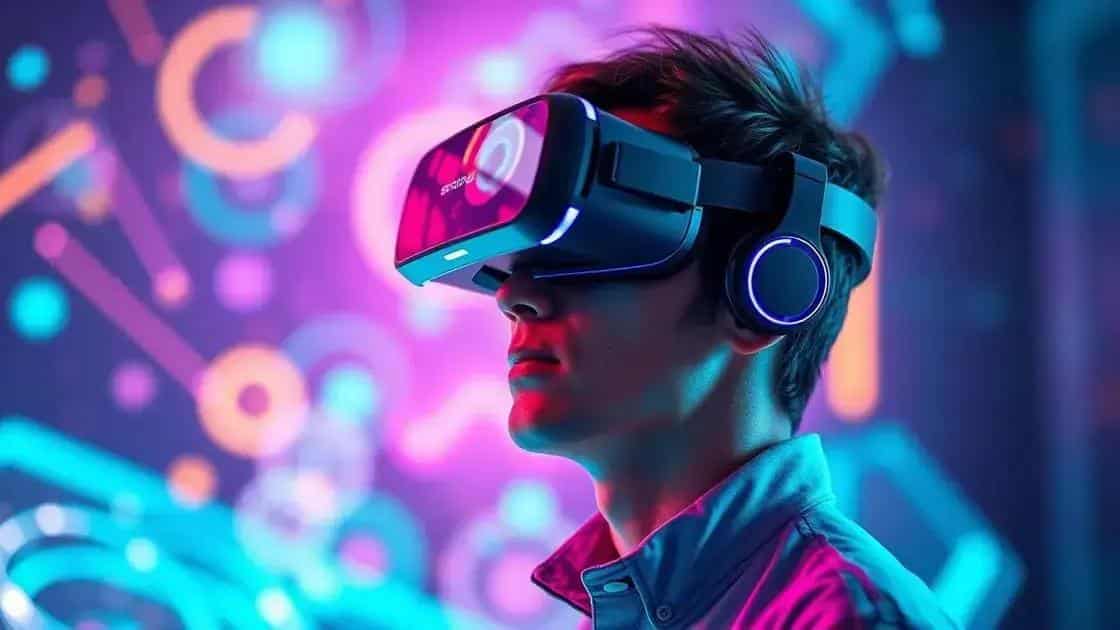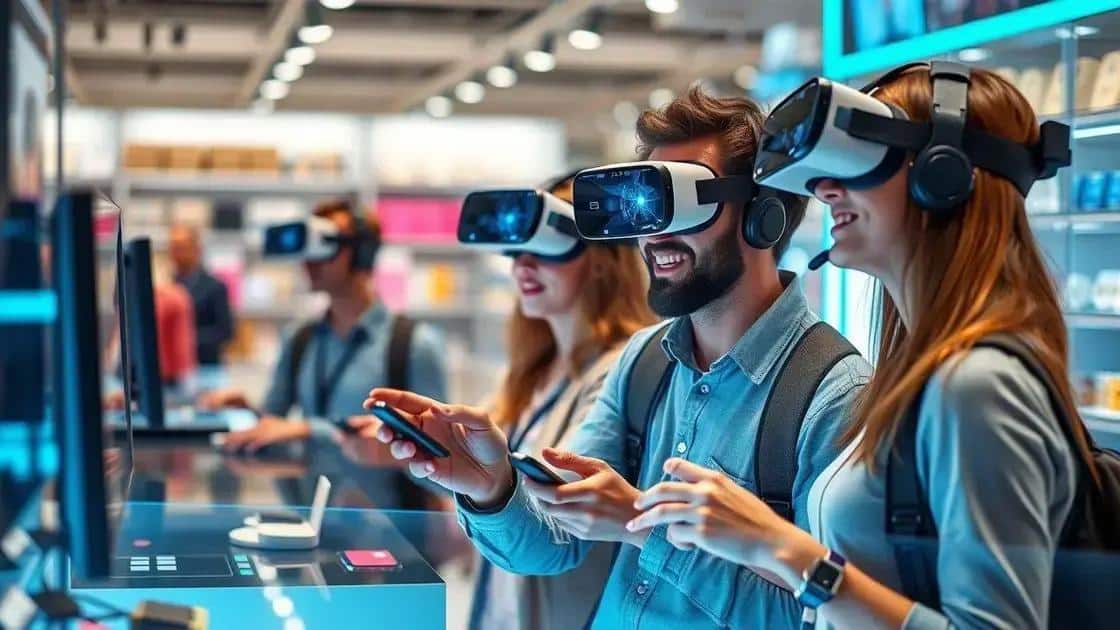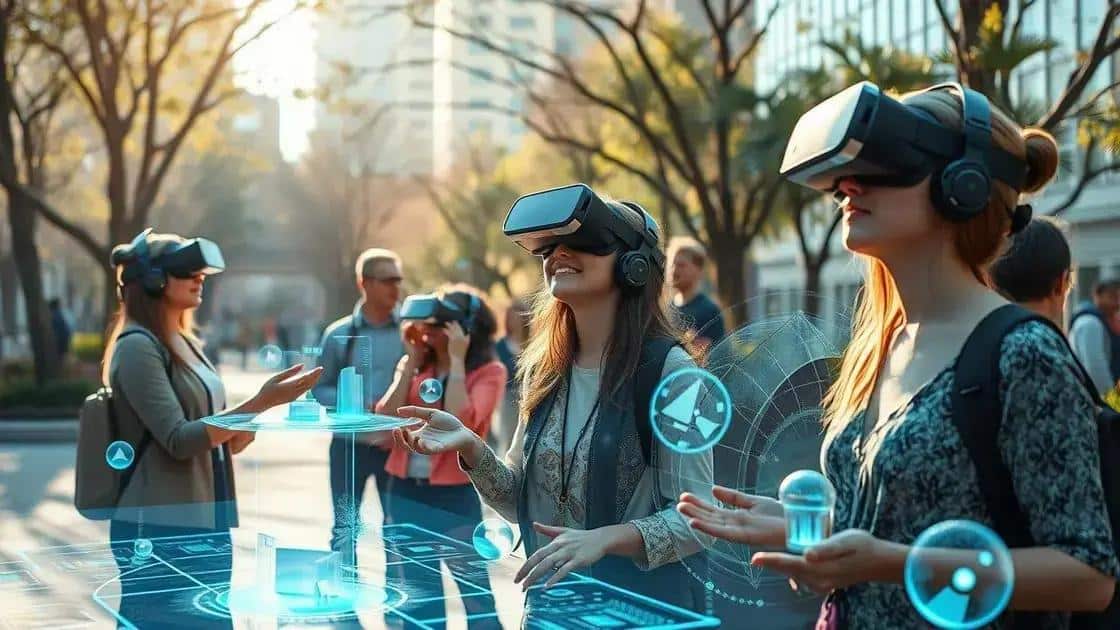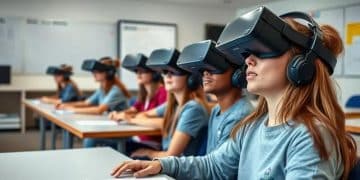Insights on vr/ar entertainment industry: trends and opportunities

The VR/AR entertainment industry is rapidly evolving, promising immersive experiences while facing challenges like high costs, accessibility, and the need for innovative content.
Insights on vr/ar entertainment industry show how these technologies are shaping our experiences in new ways. Have you ever wondered how virtual worlds can enhance storytelling? Dive in as we explore this fascinating realm.
Current trends in vr/ar technology
The current trends in vr/ar technology are reshaping the way we engage with digital content. From immersive gaming experiences to interactive training programs, the possibilities are becoming endless.
One of the most exciting developments is the rise of social VR platforms. These platforms allow users to connect with friends in virtual spaces, creating a sense of presence and community regardless of physical distance.
Emerging Technologies
Another significant trend is the integration of artificial intelligence (AI) into VR and AR experiences. AI enhances interactions, making them more personalized and adaptive. Additionally, advancements in hardware, such as lighter and more powerful headsets, are improving accessibility for users.
- Enhanced graphics and sound for a more immersive experience
- Affordability of devices is increasing, broadening user access
- Collaboration tools in VR for remote work environments
Augmented reality is also making waves, especially in retail. Brands are using AR to allow customers to visualize products in their own space before purchasing. For instance, furniture companies let users see how items fit in their homes, bridging the gap between online shopping and real-world experience.
Moreover, educational institutions are leveraging VR to create engaging learning environments. Students can explore historical sites, or conduct science experiments virtually, thus enhancing their understanding of complex subjects.
Market Growth
The market for VR and AR is also steadily growing. Analysts project that these technologies will see exponential growth in the coming years, driven by both consumer and enterprise adoption.
This growth reflects a broader shift in how society interacts with technology, moving toward increasingly immersive and interactive experiences. Users now expect high-quality, engaging content that draws them in.
As we look ahead, it’s clear that the future of the vr/ar industry is bright. With ongoing innovations and an expanding user base, these technologies are set to redefine our engagement with the digital world.
Impact of vr/ar on consumer behavior

The impact of vr/ar on consumer behavior is profound. With the rise of virtual and augmented reality, brands are adapting their strategies to engage customers in innovative ways. This technology offers a unique approach to shopping and interaction.
Consumers are increasingly drawn to immersive experiences that VR and AR provide. For example, when potential buyers can visualize products in their own environment using AR, it significantly enhances their decision-making process.
Enhancing Shopping Experiences
Retailers are leveraging these technologies to offer virtual try-ons, allowing customers to see how clothes or accessories look before purchasing. This not only saves time but reduces the likelihood of returns.
- Increased engagement with interactive content
- Higher conversion rates through immersive experiences
- Ability to showcase products in unique and memorable ways
Moreover, VR can transport shoppers to virtual stores, creating an engaging atmosphere that traditional online shopping lacks. This shift impacts how consumers perceive brands and their willingness to make purchases.
Another significant aspect is how AR allows for instant feedback. Consumers can receive personalized recommendations based on their preferences and interactions, making the shopping experience more tailored.
Changing Consumer Expectations
The consumer behavior landscape is evolving as people become accustomed to these advanced technologies. Customers now expect a seamless blend of digital and physical retail. They want brands to provide not only quality products but also exceptional experiences.
Social media platforms are also incorporating AR features that enable users to interact with brands through virtual filters, enhancing brand recognition. When consumers engage with brands in this manner, they are more likely to develop a deeper connection, ultimately fostering loyalty.
As VR and AR continue to grow, businesses must stay attuned to these changes in consumer expectations. Understanding how these technologies influence behavior is crucial for adapting marketing strategies and maintaining relevance in a competitive landscape.
Challenges facing the vr/ar entertainment sector
The challenges facing the VR/AR entertainment sector are significant as the industry continues to grow. Despite the excitement surrounding these technologies, several hurdles must be overcome to maximize their potential.
One major challenge is the cost of development. Creating high-quality VR and AR content often requires substantial investment in technology and skilled talent. This can be a barrier for smaller companies looking to enter the market.
Limited Hardware Accessibility
Another issue is the limitations in hardware accessibility. While VR headsets are becoming more popular, many consumers still find them expensive and cumbersome. The need for powerful computers or consoles to run high-end applications adds to the overall cost, making it difficult for some users to fully engage with VR experiences.
- High costs of VR and AR headsets
- Requirement for advanced technology to support experiences
- Lack of widespread knowledge about how to use these technologies
The content quality also poses challenges. Users expect immersive and exciting experiences, but not all available content meets these expectations. Developers must continually innovate to keep audiences engaged and satisfied.
Additionally, there is a concern about user comfort. Some individuals experience motion sickness or discomfort when using VR. Addressing these issues is crucial for broader acceptance, especially among casual users who may be hesitant to try immersive technologies.
Market Competition
Market competition is another significant hurdle. As more companies invest in VR and AR, standing out becomes challenging. Businesses need unique content or experiences to attract attention in an increasingly crowded market.
Furthermore, regulatory concerns about privacy and data security are rising. As VR and AR applications collect user data, ensuring this information is protected is essential to maintain consumer trust.
Overall, while the VR/AR entertainment sector shows immense promise, overcoming these challenges will require collaboration among developers, businesses, and hardware manufacturers to make these technologies more accessible and enjoyable for everyone.
Future predictions for vr/ar experiences

The future predictions for VR/AR experiences indicate a remarkable evolution in how we will interact with technology. As advancements continue, we can expect these technologies to become more integrated into our daily lives.
One prediction is the enhancement of user interfaces. Future VR and AR systems will likely utilize natural gestures and voice commands, allowing for seamless navigation without cumbersome controllers.
Wider Adoption in Various Industries
Furthermore, industries such as healthcare and education are poised to benefit immensely from VR and AR. In healthcare, for example, medical professionals can use these technologies for training simulations or remote consultations, improving patient care and learning.
- In-depth training scenarios for medical students
- Enhanced patient experiences through virtual therapy sessions
- Interactive educational tools for schools and universities
In entertainment, the demand for immersive storytelling experiences will drive innovation. We might see virtual concerts where fans can attend from anywhere in the world, or interactive movies where viewers choose the story path.
Advancements in Technology
The technological advancements behind VR and AR will also lead to improved graphics and processing power. As hardware becomes more affordable, a broader audience will gain access to these experiences, leading to increased user engagement.
Additionally, with the rise of 5G networks, latency issues will be minimized, allowing for more fluid interactions in real time. This connectivity will facilitate multiplayer experiences, where users can share virtual spaces without lag.
Finally, social interaction in virtual spaces will become more sophisticated. Users will have more personalized avatars and environments, fostering a sense of community even in a digital realm.
FAQ – Frequently Asked Questions about VR/AR Entertainment
What is the role of VR in education?
VR in education enhances learning by providing immersive experiences, allowing students to explore subjects in a hands-on way.
How can AR improve shopping experiences?
AR allows customers to visualize products in their own environment, making it easier to make informed purchase decisions.
What are some challenges facing the VR/AR industry?
Key challenges include high development costs, limited hardware accessibility, and the need for high-quality content.
How will 5G technology impact VR/AR experiences?
5G technology will reduce latency, allowing for smoother and more interactive experiences in VR and AR applications.





